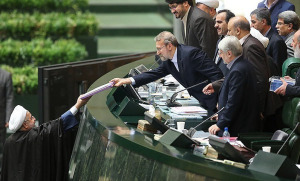December 12, 2014

President Rohani submitted his draft budget for the coming year to the Majlis Sunday, showing an increase of 5.7 percent over last year’s approved budget. Given that Rohani says inflation will be kept under 20 percent this year, that represents a sharp cutback in spending.
But the defense budget shows an immense increase in spending, largely for the Pasdar-an (Revolutionary Guards). The defense budget will rise by 33.5 percent to 282 trillion rials ($8.7 billon) with the Pasdaran budget alone amounting to 174 trillion rials ($5.4 billion) or 62 percent of the entire defense budget, shortchanging the other services.
The military budget amounts to 7.8 percent of the government’s operating budget.
The Tasnim news agency said 100 trillion of the Pasdar budget or 58 percent was just for Khatam ol-Anbia, the Pasdaran’s construction arm. It said this budget was double last year’s, but it did not say what warranted that huge jump.
Rohani said the budget was in balance and would involve no deficit. But few believe that. According to recent figures published by the Central Bank, the government spent more than twice what it took in during the first quarter of the current Persian year.
The current year’s budget was based on an assumption of an average oil price of $100 and sales of 1.5 million barrels a day. But the average price of an OPEC barrel so far this year has fallen below $100 and exports so far this Persian year have averaged just 1.1 million barrels a day.
The government last week said the budget for next year (starting at Now Ruz, March 21) would be based on an average price of $70 a barrel, even though the price is already down to $66. Then the state news agency said the math in the budget was actually based on an average price of $72 a barrel. The budget assumes a reduction in oil exports to 1.4 million barrels a day. But as long as sanctions remain in place, the country is unlikely to be able to export more than the current average of 1.1 million.
The budget is actually divided into three parts—the government’s operating budget, the development or capital budget, and the budget for state-owned companies and banks.
As an indication of just how much the state still dominates the economy, more than two-thirds of the total budget is for state-owned enterprises.
Here is the breakdown of the budget using the current free market exchange rate of about 32,500 rials to the dollar.
Rials $
Budget trillions bns
Operating 2196 67.6
Capital 461 14.2
State firms 5722 176.1
Total 8379 257.9
In presenting the budget to the Majlis, Rohani said the country must promote non-oil exports in order to move away from dependence on oil. This is a refrain that has been heard every year since long before the revolution. Actually, the revolutionary regime has overseen a huge increase in exports other than crude oil. But the growth has been largely in oil-based exports, such as petrochemicals, and in other extractive fields, such as iron ore. The growth in industrial exports has been small.
Rohani said, “The decline in the price of oil provides a new opportunity to accelerate this” shift away from oil exports. This is in line with the classic regime argument that sanctions have been good for Iran because they allow the country to develop its own industries and avert dependence on the outside world.
The budget provides for a 14 percent salary boost at Now Ruz for civil servants, a figure that represents a 5 percent decrease in purchasing power if one accepts Rohani’s statement in his budget message that inflation for the current year will fall below 20 percent by Now Ruz.